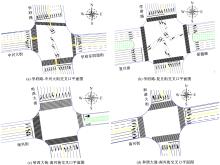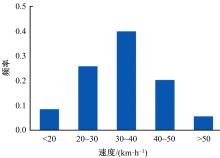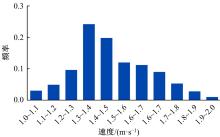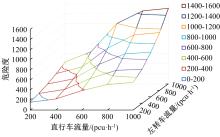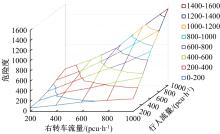Journal of Jilin University(Engineering and Technology Edition) ›› 2023, Vol. 53 ›› Issue (7): 1962-1969.doi: 10.13229/j.cnki.jdxbgxb.20210969
Exclusive phase setting condition of signalized intersection based on risk analysis
Guo-zhu CHENG1( ),Lin SHENG1,Hao ZHAO1,Tian-jun FENG2(
),Lin SHENG1,Hao ZHAO1,Tian-jun FENG2( )
)
- 1.School of Traffic and Transportation,Northeast Forestry University,Harbin 150040,China
2.School of Transportation Science and Engineering,Jilin University of Architecture,Changchun 130118,China
CLC Number:
- U491.7
| 1 | AASHTO. Highway Safety Manual[M]. Washington, DC: American Association of State Highway and Transportation Officials,2010. |
| 2 | 朱顺应,蒋若曦,王红,等. 机动车交通冲突技术研究综述[J]. 中国公路学报,2020,33(2):15-33. |
| Zhu Shun-ying, Jiang Ruo-xi, Wang Hong, et al. Review of research on traffic conflict techniques[J]. China Journal of Highway and Transport,2020,33(2):15-33. | |
| 3 | El-Basyouny K, Sayed T. Safety performance functions using traffic conflicts[J]. Safety Science,2013,51(1):160-164. |
| 4 | Zhang X, Liu P, Chen Y, et al. Modeling the frequency of opposing left-turn conflicts at signalized intersections using generalized linear regression models[J]. Traffic Injury Prevention,2014,15(6):645-651. |
| 5 | Hussein M, Sayed T, Reyad P, et al. Automated pedestrian safety analysis at a signalized intersection in New York City: automated data extraction for safety diagnosis and behavioral study[J]. Transportation Research Record,2015,2519(1):17-27. |
| 6 | Autey J, Sayed T, Zaki M H. Safety evaluation of right-turn smart channels using automated traffic conflict analysis[J]. Accident Analysis & Prevention,2012,45:120-130. |
| 7 | Gettman D, Pu L, Sayed T, et al. Surrogate safety assessment model and validation[R]. McLean: Turner-Fairbank Highway Research Center at the Federal Highway Administration, 2008. |
| 8 | Wang C, Stamatiadis N. Evaluation of a simulation-based surrogate safety metric[J]. Accident Analysis & Prevention, 2014,71:82-92. |
| 9 | Essa M, Sayed T. Transferability of calibrated microsimulation model parameters for safety assessment using simulated conflicts[J]. Accident Analysis & Prevention, 2015, 84: 41-53. |
| 10 | Wang C, Xu C, Xia J, et al. A combined use of microscopic traffic simulation and extreme value methods for traffic safety evaluation[J]. Transportation Research Part C: Emerging Technologies,2018,90:281-291. |
| 11 | 郭延永,刘攀,徐铖铖,等.基于交通冲突模型的信号交叉口右转设施安全分析[J].中国公路学报,2016,29(11):139-146. |
| Guo Yan-yong, Liu Pan, Xu Cheng-cheng, et al. Safety analysis of right-turn facility at signalized intersection using traffic conflict model[J]. China Journal of Highway and Transport,2016,29(11):139-146. | |
| 12 | 王雪松,罗楝.信号控制交叉口交通冲突特征与影响因素[J]. 城市交通,2016,14(6):60-66. |
| Wang Xue-song, Luo Lian. Traffic conflict characteristics and influential factors at signalized intersections[J]. Urban Transport of China,2016,14(6):60-66. | |
| 13 | 朱彤,白玉,杨晓光,等.平面交叉口交通冲突安全评价失效分析及改进方法研究[J].中国安全科学学报,2008(2):157-161, 179. |
| Zhu Tong, Bai Yu, Yang Xiao-guang, et al. Failure analysis on safety assessment method for traffic conflicts at level crossing and its improvement[J]. China Safety Science Journal,2008(2):157-161, 179. | |
| 14 | 成卫,李江.模糊聚类法在基于交通冲突技术的交叉口安全评价中的应用[J].交通运输系统工程与信息,2004(2):48-50, 55. |
| Cheng Wei, Li Jiang. The application of the fuzzy clustering method in evaluation of traffic safety based on traffic conflict at intersection[J]. Journal of Transportation Systems Engineering and Information Technology,2004(2):48-50, 55. | |
| 15 | 王晨,夏井新,陆振波,等.基于微观仿真与极值理论的城市交叉口安全评价方法[J]. 中国公路学报,2018,31(4):288-295, 303. |
| Wang Chen, Xia Jing-ran, Lu Zhen-bo, et al. Safety evaluation method based on traffic simulation and extreme value theory[J]. China Journal of Highway and Transport,2018,31(4):288-295, 303. | |
| 16 | Guo Y, Sayed T, Zheng L, et al. An extreme value theory based approach for calibration of microsimulation models for safety analysis[J]. Simulation Modelling Practice and Theory,2021,106:102172. |
| 17 | 杨晓光,蒲文静,龙亮.基于交通冲突分析的交叉口机动车信号灯设置[J].同济大学学报:自然科学版,2005(12):1596-1599. |
| Yang Xiao-guang, Pu Wen-jing, Long Liang. Traffic signal warrant study based on traffic conflict analysis for uncontrolled intersections[J]. Journal of Tongji University(Natural Science),2005(12):1596-1599. | |
| 18 | 苏岳龙,姚丹亚,张毅.基于机动车行人冲突分析的右转专用相位设置仿真[J]. 公路交通科技,2009,26(7):133-138. |
| Su Yue-long, Yao Dan-ya, Zhang Yi. Exclusive right-turn phase setting simulation based on vehicle/pedestrian conflict analysis[J]. Journal of Highway and Transportation Research and Development,2009,26(7):133-138. | |
| 19 | 徐建闽,王文静,马莹莹,等. 基于延误时间最小的右转专用信号设置条件研究[J]. 公路工程,2018,43(3):101-105, 183. |
| Xu Jian-min, Wang Wen-jing, Ma Ying-ying, et al. Research on setting exclusive right-turning phase based on minimum delay time[J]. Highway Engineering,2018,43(3):101-105, 183 | |
| 20 | 戴学臻,张波.基于人车冲突分析的转向专用相位设置研究[J].武汉理工大学学报:交通科学与工程版,2012,36(1):47-50. |
| Dai Xue-zhen, Zhang Bo. Research on setting exclusive turn phase based on pedestrian-vehicle conflict analysis[J]. Journal of Wuhan University of Technology(Transportation Science & Engineering),2012,36(1):47-50. | |
| 21 | 潘福全,陆键,项乔君,等. 无信号平面交叉口安全服务水平计算模型[J]. 交通运输工程学报,2007(4):104-111. |
| Pan Fu-quan, Lu Jian, Xiang Qiao-jun, et al. Computation model of safety level of service for non-signalized intersection[J]. Journal of Traffic and Transportation Engineering,2007(4):104-111. | |
| 22 | Hayward J C. Near-miss determination through use of a scale of danger[J]. Highway Research Record, 1972. |
| 23 | 项乔君,陆健,卢川,等. 道路交通冲突分析技术及应用[M].北京: 科学出版社,2008. |
| 24 | 陈曦. 基于交通冲突定量分析的交叉口危险度模型研究[D]. 北京:北京交通大学交通运输学院,2012. |
| Chen Xi. Research on the intersection risk degree model based on traffic conflict quantitative analysis[D]. Beijing: School of Transportation, Beijing Jiaotong University, 2012. |
| [1] | Heng-yan PAN,Yong-gang WANG,De-lin LI,Jun-xian CHEN,Jie SONG,Yu-quan YANG. Evaluating and forecasting rear⁃end collision risk of long longitudinal gradient roadway via traffic conflict [J]. Journal of Jilin University(Engineering and Technology Edition), 2023, 53(5): 1355-1363. |
| [2] | Xue XIAO,Ke-ping LI,Bo PENG,Man-wei CHANG. Integrated lane⁃changing model of decision making and motion planning for autonomous vehicles [J]. Journal of Jilin University(Engineering and Technology Edition), 2023, 53(3): 746-757. |
| [3] | Rong-han YAO,Wen-tao XU,Wei-wei GUO. Drivers' takeover behavior and intention recognition based on factor and long short⁃term memory [J]. Journal of Jilin University(Engineering and Technology Edition), 2023, 53(3): 758-771. |
| [4] | Jing WANG,Feng WAN,Chun-jiao DONG,Chun-fu SHAO. Modelling on catchment area and attraction intensity of urban rail transit stations [J]. Journal of Jilin University(Engineering and Technology Edition), 2023, 53(2): 439-447. |
| [5] | Min MA,Da-wei HU,Lan SHU,Zhuang-lin MA. Resilience assessment and recovery strategy on urban rail transit network [J]. Journal of Jilin University(Engineering and Technology Edition), 2023, 53(2): 396-404. |
| [6] | Song FANG,Jian-xiao MA,Gen LI,Ling-hong SHEN,Chu-bo XU. Traffic risk analysis of moving work zone on right lane of city expressway [J]. Journal of Jilin University(Engineering and Technology Edition), 2022, 52(8): 1786-1791. |
| [7] | Song-xue GAI,Xiao-qing ZENG,Xiao-yuan YUE,Zi-hao YUAN. Parking guidance model based on user and system bi⁃level optimization algorithm [J]. Journal of Jilin University(Engineering and Technology Edition), 2022, 52(6): 1344-1352. |
| [8] | Hong-feng XU,Hong-jin CHEN,Dong ZHANG,Qian-hui LU,Na AN,Xian-cai Geng. Fully⁃actuated signal timing technique for isolated signalized intersections in connected vehicle environment [J]. Journal of Jilin University(Engineering and Technology Edition), 2022, 52(6): 1324-1336. |
| [9] | Li-feng WANG,Zi-wang XIAO,Sai-sai YU. New risk analysis method based on Bayesian network for hanging basker system of multi-tower cable-stayed bridge [J]. Journal of Jilin University(Engineering and Technology Edition), 2022, 52(4): 865-873. |
| [10] | Xian-yan KUANG,Zi-ru CHEN. Dynamic game comity behavior at pedestrians′ crossing on unsignal-controlled roads based on cellular automata [J]. Journal of Jilin University(Engineering and Technology Edition), 2022, 52(4): 837-846. |
| [11] | Guo-zhu CHENG,Qiu-yue SUN,Yue-bo LIU,Ji-long CHEN. Cut⁃in behavior model based on game theoretic approach on urban roads [J]. Journal of Jilin University(Engineering and Technology Edition), 2022, 52(12): 2839-2844. |
| [12] | Heng-yan PAN,Wen-hui ZHANG,Bao-yu HU,Zun-yan LIU,Yong-gang WANG,Xiao ZHANG. Construction and robustness analysis of urban weighted subway⁃bus composite network [J]. Journal of Jilin University(Engineering and Technology Edition), 2022, 52(11): 2582-2591. |
| [13] | Zhuang-lin MA,Shan-shan CUI,Da-wei HU. Urban residents' low⁃carbon travel intention after implementation of driving restriction policy [J]. Journal of Jilin University(Engineering and Technology Edition), 2022, 52(11): 2607-2617. |
| [14] | Jing-xian WU,Hua-peng SHEN,Yin HAN,Min YANG. Residents' commuting time model under the nonlinear impact of urban built environment [J]. Journal of Jilin University(Engineering and Technology Edition), 2022, 52(11): 2568-2573. |
| [15] | Jie MA,Jia-jun HUANG,Jun TIAN,Yang-hui DONG. Simulation modeling of pedestrian target decision⁃making in evacuation process in transfer corridors of subway stations [J]. Journal of Jilin University(Engineering and Technology Edition), 2022, 52(11): 2600-2606. |
|
||
